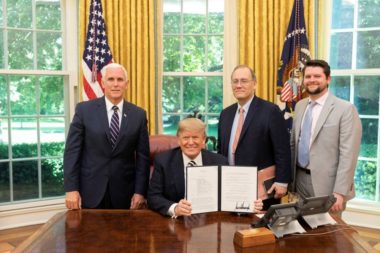ULA and its launch industry competitors in pitched fight over regulations – SpaceNews
“On National Security” appears in every issue of SpaceNews magazine. This column ran in the July 29, 2019 issue. The online version was updated Aug. 3

United Launch Alliance on July 19 posted on the Federal Aviation Administration’s website a detailed comment in support of the agency’s proposed revisions of commercial launch and re-entry rules. Shortly after the company’s comments went public, ULA CEO Tory Bruno tweeted: “FAA did a superb job increasing flexibility while maintaining public safety.”
ULA, and its parent companies Boeing and Lockheed Martin, have stood virtually alone in their support of the FAA’s rules revision. In the past week, Northrop Grumman, Airlines for America, Alaska Aerospace, Astra Space and CDSE have aligned with ULA.
Commercial space launch players, meanwhile, continue to challenge the agency to make further changes, arguing that what the FAA has proposed amounts to a crushing blow to entrepreneurial companies that are trying to build cost-effective space transportation infrastructure.
In response to the commercial sector backlash, the FAA twice has extended the public comment period since it released a notice of proposed rulemaking April 15. The latest word from the FAA is that it will keep accepting comments until Aug. 19.
The regulatory battle over launch licensing, whatever its outcome, has huge implications. ULA is especially concerned about SpaceX and Blue Origin gaining a competitive edge if regulatory constraints are eased in ways that would allow commercial players to grow their business, lower their cost and push ULA into a corner.
According to industry sources, ULA worries that if the FAA keeps extending the comment period, it will increase the chances that its commercial competitors will gain concessions from the FAA.
“I don’t blame ULA,” Eric Stallmer, the president of the Commercial Spaceflight Federation, told SpaceNews. The revised rules the FAA proposed favor large companies that have bureaucracies in place to comply with onerous requirements, he said. “But for new entrants, small launch companies, reusable launch companies, the rules are backbreaking. It’s a tremendous barrier to entry. It’s almost as if the Russians and the Chinese wrote these rules.”
The FAA in its proposed revisions, for example, changed the rules on how safety standards are interpreted, which requires an army of lawyers to figure out, he said. A company like ULA can throw more money at the problem, he said. “For the smaller companies, it almost seems designed to shut them out.”
The commercial industry is asking for a “performance-based” approach to safety rather than prescriptive rules, said Stallmer. “They should not tell you how to skin the cat. They just tell you to skin the cat.”
The Trump administration kicked off the regulatory review in May 2018 when it issued Space Policy Directive 2 to streamline regulations on the commercial use of space. “The White House wants to make space more accessible, but safety is always paramount, first and foremost,” said Stallmer.
But ULA fears the FAA is being too accommodating to commercial companies, said an industry source who declined to be named due to the sensitivity of the subject. “The Commercial Spaceflight Federation, along with SpaceX and Blue Origin want the public to believe that we are now at a point with space launch similar to air travel. But we’re not there yet. We are decades away from that.”
The FAA is going out of its way to address the concerns of commercial firms, the source said. “The FAA has solicited feedback and proposed new rules. Those new rules can continue to change. Because CSF didn’t get everything they asked for, they want to now continue the debate and browbeat the FAA so they get their way.”
The fight over launch regulations has become another front in what to date has been a ULA-SpaceX battle for dominance in the civil, commercial and national security launch markets. ULA is still adjusting to life with SpaceX, which has gained ground with Air Force customers putting a premium on low price.
Meanwhile, Blue Origin — which is building the BE-4 main engines for ULA’s Vulcan rocket — is also vying for Air Force launch contracts with a New Glenn rocket that’s already lining up commercial customers ahead of its 2021 debut. If regulators make it easier for newcomers like Blue Origin to field new rockets, the competitive pressures on ULA will only increase.
The government has a responsibility to protect the public, make range operations safe, and ensure licenses are only given to rockets that have been sufficiently tested. But the FAA must decide how much risk is acceptable in a market where there will be multiple launch providers of different shapes and sizes.
A resolution is still months away. Commercial companies are hoping that the additional time the FAA allowed for comments will help them make the case to the administration that change is needed at a pivotal moment in the history of the nation’s space efforts. The administration wants the commercial sector to thrive, Stallmer said. “Especially if they want to go to the moon and Mars, you’re not going to get there with business as usual.”
Sandra Erwin covers military space for SpaceNews. She is a veteran national security journalist and former editor of National Defense magazine.







